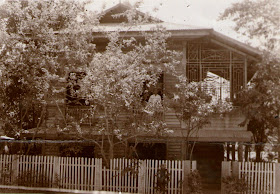Sta. Cruz – Sto. Niño
is an urban barangay at the town of Balamban with a total land area of 43
hectares. It is bounded by Baliwagan in the north; Cantuod & Prenza in the
east; Aliwanay in the south; and the Tañon Strait in the west.
NAME-ORIGIN
& BRIEF HISTORY OF THE BARANGAY
According
to oral history during the Spanish period the barangay was only named as Santa
Cruz.1 Probably the said barrio which comprised the poblacion along with Aliwanay and
Baliwagan was really named after Barrio de Santa Cruz, a neighborhood near the
center of Seville, Andalucia, Spain whose population in the 18th
century was only second to another neighborhood which was Toledo in the entire
Iberian Peninsula. Seville’s Barrio de Santa Cruz was an old judería (Jewish quarter) while the city
of Seville itself was conquered by the Muslims and was regained back by
Ferdinand III of Castile who concentrated on the city’s Jewish population
which underwent
a major process of urban renewal, including the conversion of a former
synagogue into the current Church of Saint Bartholomew.2
Considering
the oral histories that recounted that (a) the poblacion before it was
transformed into a pueblo by the Spaniards was predominated by the Muslims who
continuously marauded it when it was conquered by the Spaniards; (b) the
poblacion was known as Kangma
believed to be inhabited by early Malay settlers but who were actually Tibetans
(see Unit III, Chapter Ten: Cambuhawe)
who being Buddhists were often mistaken as Jews by Christian missionaries
during their visits in Southeast Asia especially in Java & Sumatra in the
13th century; and (c) by its proximity to Hinulawan which was
renamed as Toledo after Toledo which is
a neighborhood of Barrio de Santa Cruz in Seville when it was granted a
separation from Balamban -- it would be very probable that barangay Sta. Cruz -
Sto. Niño was likened before to the scenarios which had been observed at Barrio
de Santa Cruz in the 18th century. If this hypothesis is true then
it could also be very possible that the site of the Church of Saint Francis of
Assisi was a site of a Buddhist temple before it was converted into a Christian
church.
It
was believed that the old town of Balamban at the coast of Barangay Nangka was
established as a pueblo or town by
the Spaniards in 17453 but submerged in the sea due to a tsunami at
around 1876 thus another pueblo had
been built in the present site.4 From this view, a local Barrio de
Santa Cruz might be established within the said year as a barrio that partly
composed the new poblacion which
later on was renamed as Barangay Sta. Cruz – Sto. Niño after the two existing
streets of the barangay that served also as its sitios.
The
barangay holds its fiesta every 3rd day of May with the Santa Cruz
(Holy Cross) as its patron. In the past years it held annual Santacruzan by which selection of Reina Elena was considered as the
earliest form of beauty pageant in Balamban.
It
is a home of prominent families in Balamban like the Binghay, Karamihan, and
Paulin and of numerous Spanish ancestral houses.
Among
the said Spanish ancestral houses in the barangay which are still existing at
present are: (a) the house of the late Teofisto Demetria, the Municipal
Treasurer during the time of Mayor Eufracio Yntig (1945-1946), which was built
in the 1930’s that was hit by bullets during World War II (some of the bullet
holes at the ceiling are still evident); (b) the house of the late Mayor Exasperanza
Sanchez – Binghay which ground floor is converted into Agencia Balamban (a
pawnshop); the house of the late Mayor Socrates Gonzalez which is converted
into Araneta Learning Center; and the house of the grandparents of Mayor
Exasperanza Sanchez – Binghay which ground floor is converted into Mercury
Drugstore and RCBC.
The
St. Francis Academy, the private high school located in the barangay, had
somehow managed to grow, no matter how slowly, from the time of its opening
early in the 1950s. The SFA’s management through the years eventually passed on
to Filipino hands, so that during the celebration of its Golden Jubilee on
September 29 to October 1, 2000, the Mother Superior was a Filipina: Sister
Josefina de los Reyes, ICM.
In
a manner of saying, the growth of SFA may be considered also as a gauge of the
growth of Balamban itself. Many of its graduates, during its half-century of
existence, succeeded in various fields of endeavor along their respective lines
of expertise. A number of graduates became priests, many adopted teaching as a
profession, and a few became elective municipal officials and appointive line
bureau directors of the government. Many moved to other places such as
Mindanao, the United States and Europe. A number became lawyers, medical doctors,
or men who started their own businesses as entrepreneurs. Prominent among them
were Msgr. Achilles Dakay who became the spokesman of Cebu Archbishop Ricardo
Cardinal Vidal, Socrates Gonzales who became the mayor of Balamban through the
martial law years, and the two Roperos brothers, namely: Nerius who graduated
salutatorian of his SFA class and later became the director of the Bureau of
Plant Industry agriculture department; and Cesar who the dean of the graduate
school of Public Administration of Western Mindanao State University in
Zamboanga City.1


No comments:
Post a Comment